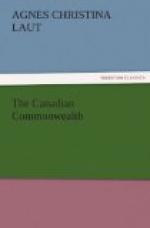V
Let us look at this question of rates!
Ordinarily the rate on wheat from Chicago to New York is about ten to twelve cents a bushel; from New York to Liverpool about three to seven cents. That is, for one thousand miles (roughly) the rate by rail is ten cents. For three thousand miles the rate by water is three cents. That is, one cent buys the shipper one hundred miles by rail. One cent buys him one thousand miles by water. Get out a chart and figure out for yourself what the saving means on wheat via Panama to Liverpool on a crop—we’ll say—of one hundred million bushels, Alberta’s future share alone, leaving Saskatchewan and Manitoba crops to continue going to Liverpool by Fort William and Montreal. You can figure the distance to Liverpool via Panama twice or even three times as far as via Atlantic ports, long as water rates are to rail, as one to ten, the saving on a one-hundred-million-bushel crop for a single year is enough to buy terminals, build elevators and run civic ships as Boston and New Orleans and St. Louis and Kansas City and Portland are doing. Via Tehuantepec the saving was eight cents a bushel. At that rate your saving in a year would be eight million dollars for Alberta wheat alone, not counting dairy products, which are bound to become larger each year, and coal, which will yet bring the same wealth to Alberta as to Pennsylvania, and lumber, on which the saving is as one to four.
Please note one point! It is a point usually ignored in all comparisons of water and rail rates. While sea and lake are the cheapest method of transportation in the world, canals (unless some other nation builds them as the United States built Panama) are not so cheap as sea and lake. When you add to the cost of canals, the interest on cost, the maintenance, and charge that up against traffic—for it doesn’t matter, though the government does maintain canals; you pay the bill in the end—canal rates come higher than rail rates. But in Canada’s use of Panama, Canada is not paying for the building of the canal; and the Lord pays the upkeep of the canal of the sea.
Take this question of Vancouver rates, from which Canada is standing back so inertly! Take the latest rates issued! These are subject to change and correction, but that does not affect final conclusions. It costs Manitoba and Saskatchewan from twelve to nineteen cents a hundred weight to send grain to Fort William, then during open navigation from four to five cents to reach seaboard at Montreal. It costs Alberta, being farther west, twenty-five cents to reach Fort William; but, as a matter of fact, her wheat can seldom reach Fort William before the close of navigation; so she must pay twenty-five cents more to send her wheat on down to St. John, and five to six cents from St. John to Liverpool, or in all fifty-five cents. The Alberta rate is twenty-two cents plus a fraction to Vancouver, or forty-five cents to Liverpool. Now, Alberta wants to know: Why is she charged twenty-two and a fraction cents for six hundred fifty miles west, and only twenty-five cents for one thousand two hundred miles east?




